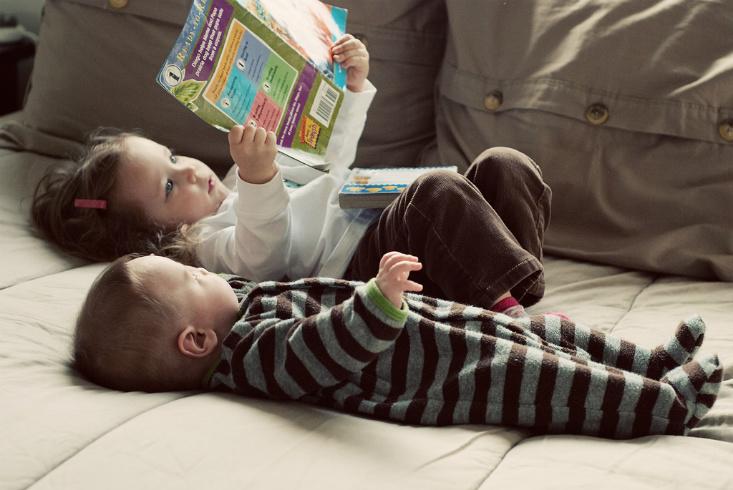
To adults learning a second language, it hardly seems fair: As they stumble their way through conjugation drills, fret over grammar textbooks, and fill in worksheets on constructing subordinate clauses, their children sop up the language while finger painting at preschool. Within months, correct syntax pours itself out of the tykes’ mouths, involving no apparent mental exertion on their part.
In her 2010 TED talk, researcher Patricia Kuhl described children as language-learning “geniuses.” In contrast, people who start learning a language in adulthood rarely reach the summit of native-like proficiency, even after decades of strenuous effort. An enduring scientific mystery is why adults, with their superior cognitive powers, ultimately do less well than children at language learning.
Part of the answer lies with the curse of prior knowledge: Once neural commitments are made to the patterns of a first language, these interfere with the ability to learn a new set of structures, especially if they’re very different from the first. But another part of the story may be that adults do badly not in spite of, but because of, their greater intellectual ability.
Evidence is mounting for the existence of two very different learning systems, each with its own neural hardware: a reflective system involving knowledge that can be brought into consciousness and verbalized, and a more implicit reflexive system. The reflective system is ideal for learning calculus or how to identify a logical fallacy, activities at which adults outshine children. But when it comes to learning how to ride a bike, explicit instruction about muscle physiology or the physics of motion is not as helpful as raw intuition and repeated trial and error—see what keeps you from falling over, and instinctively do more of that.
These two systems vie with each other for control. As children grow into adulthood, the reflective system can handle increasingly complex information and takes on a greater role in learning material that had previously been left to the more primitive reflexive system. Adults, but not small children, are able to confront the syntax of a language armed with explicit grammatical rules like: In French, make sure that an adjective is assigned the same gender as the noun it describes.
And this may be their downfall.
Adult participants were soundly outperformed by rats on this more complex task! Presumably the rats, not being tempted to form an explicit rule, relied on the more optimal reflexive system.
The reflective system may be a bad tool for learning certain aspects of language. In a study led by Amy Finn, participants were tasked with learning the patterns of a made-up language; half of them were told to deliberately try to figure out the underlying patterns, while the rest were instructed simply to listen to the language while coloring. The deliberate learners were worse at identifying abstract grammatical categories (but better at a simpler task that required identifying individual words from running speech). In a separate study headed by Bharath Chandrasekaran, encouraging English speakers to rely on reflective rather than reflexive learning thwarted their ability to categorize tones in Mandarin; this is a skill that is crucial for distinguishing Mandarin words, and one that many English speakers struggle with.
Paradoxically, it’s the most complex information that’s often best left to the more intuitive reflexive system, perhaps because it’s harder to pin down complicated information with an explicit rule. And that tendency extends beyond language to other kinds of information, too.
In a study conducted at the University of Leuven, in Belgium, Ben Vermaercke and his colleagues designed two tasks that involved learning to sort stripe-filled images into categories. In one of these tasks, the categories were each based on one simple characteristic. (For example, one category might consist of images in which stripes were angled slightly off the vertical axis, while another category might include only images with thick stripes rather than fine ones). In the second task, the categories were more complicated, and based on both stripe thickness and orientation; as no single rule defined each category, judgments were best made on intuitive impressions of overall similarity.
Adult participants performed poorly on the second task relative to the first, and—as if it weren’t bad enough to be outdone by children at language learning—they were soundly outperformed by rats on this second, more complex task! Presumably the rats, not being tempted to form an explicit rule, relied on the more optimal reflexive system.
Language is generally more like the complicated categorization task: It’s riddled with patterns that are not readily verbalized, patterns that seem maddeningly illogical. A shining example is the English definite article the, whose proper use bewilders even very fluent non-native speakers of English. A glance at the following sentences shows the problem:
Pam took the train to Philadelphia.
Pam arrived from Philadelphia by train.
Cary walked to school every day.
Cary walked to the store every day.
Native speakers may have no clue why definite articles should be inserted in some cases but not in others, but they know it sounds jarring when someone gets it wrong. That’s likely because they’ve learned these patterns not as overthinking, overly intellectual adults, but as the naïve, intuitive language-learning geniuses they were as children.
Julie Sedivy teaches at the University of Calgary. She is the author of Language in Mind: An Introduction to Psycholinguistics and the co-author of Sold on Language: How Advertisers Talk to You and What This Says About You.


























